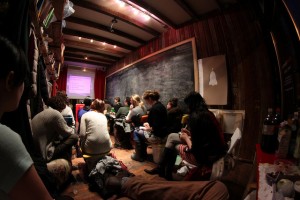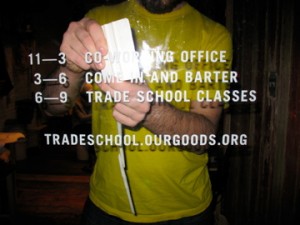Kickstarter, an online platform launched in Spring 2009 and based in New York City, calls itself “a new form of commerce and patronage” [1]. It enables creative projects in need of funding to be presented online and allows interested parties to consider their merits and potentially fund them – a method frequently called “crowd funding.”
Kickstarter focuses on projects involving art, comics, dance, design, fashion, film, food, games, music, photography, publishing, technology, and theatre. [2]. The funders, called “backers” in Kickstarter’s lexicon, are not lenders, investors, or traditional donors who might receive a tax deduction in the United States as a partial incentive for their funding. Instead, they receive the honour of having contributed to the realisation of a creative project, along with access to a range of unique rewards and experiences offered for different levels of funding. Backers’ funds are at first called “pledges” because the funding is only processed if the project meets its own funding goal by its specified date; the fundraising relies heavily on the creators’ personal and professional networks and their own ability to make a compelling case for their projects [3].

Kickstarter Perry Chen answered a barrage of questions from students about the independent project fundraising site. Trade School, How to Raise $ on Kickstarter, 2010, © All rights reserved by OurGoods.org
Kickstarter processes the funds through Amazon.com, a familiar and simple venue for would-be funders who already have an Amazon account. However, although anyone in the world can pledge funds with a major credit card, in order to be eligible to present a project on Kickstarter and seek funding, one must meet the requirements for receiving Amazon payments, which include being “a US resident and at least 18 years of age with a social security number (or EIN), a US bank account, US address, US state-issued ID (driver’s license), and major US credit or debit card” [4]. According to Kickstarter’s Web site, “We’re working hard to open up to more countries” [5].
OurGoods, an organisation that challenges conventional ideas about value, made use of Kickstarter to help realise an iteration of its education branch called Trade School. OurGoods describes itself as “a barter network for the creative community” [6] that is run on “mutual respect” [7]. Caroline Woolard of OurGoods contrasts their network with larger contemporary bartering networks: “OurGoods focuses on creative projects made by creative people, not random manufactured objects that can be traded anonymously” [8]. As an example, Woolard highlights the project page of ADAMA, a documentary film that “follows the story of Adama Bah, a 16-year-old Muslim girl growing up in Harlem, who was detained by the FBI after she was accused of being a ‘potential suicide bomber.’” Its creator – the filmmaker and teaching artist David Felix Sutcliffe – needs a range of promotion and packaging design services for which he will exchange camera and video editing skills. In this context, OurGoods’s idealistic mission-statement equivalent merits highlighting: “OurGoods exists so that creative people can help each other produce independent projects. More work gets done in networks of shared respect and shared resources than in competitive isolation. By honouring agreements and working hard, members of OurGoods will build lasting ties in a community of enormous potential” [9].

Rich Watts putting vinyl on GrandOpening doors. Trade School, Putting on Hours, 2010, © All rights reserved by OurGoods.org
OurGoods utilised Kickstarter to fund the second iteration of Trade School, an in-person education program in which students are taught specific subjects in one-session classes in exchange for non-cash items that the teacher would like. A list of past courses reflects the diversity of the available learning experiences and the instructors’ wish lists of barter items. While it might seem contradictory that a barter-based project would seek direct funding, Woolard explains, “We can’t run solely on barter. Until landlords start accepting art and design work for rent, we’re stuck in the cash economy” [10]. Trade School’s first iteration took place in 2010 at GrandOpening, a business and space in Manhattan that creates “interactive stores and events that get public attention and engage the community”[11] – a variation of the so-called pop-up store. With the help of crowd funding on Kickstarter, Trade School opened again in 2011 to further celebrate “practical wisdom, mutual respect, and the social nature of exchange” [12]. Woolard sheds light on Trade School in relation to the larger free-education context: “Trade School demonstrates that the context of learning is important too – paying for education teaches about debt and the hoarding of knowledge, bartering for education teaches about mutual aid and the reality that everyone has something to offer. Teachers have specific needs (vegetables, old records, research help, etc.) that students can meet” [13].
Emphasising Kickstarter’s usefulness to those with existing large networks, as was the case with Trade School after its first successful run, Woolard says, “Kickstarter helped us spread the Trade School model (barter for education) to other cities and countries – we now have inspired groups to organize Trade School Milan and Trade School Charlottesville, VA” [14].
While Trade School is listed on Kickstarter as “A Conceptual Art project in New York, NY by OurGoods,” its status as art remains compellingly uncertain. Trade School has taken place in a traditional art context at the Whitney Museum of American Art as a one-night event called Trade School at the Whitney: A Coincidence of Wants and was also promoted on their events calendar under the heading of “Courses & Workshops.” Woolard has stated, “If, as Amy Whitaker says, ‘art is anything that changes the world to allow itself to exist,’ then OurGoods is art. Creative Time is giving us $5K to make a project room at Living As Form, so Nato Thompson [chief curator at Creative Time] thinks OurGoods might be art” [15].
In the kind of multidirectional and sometimes self-reflexive way that networked projects hyperlink and circulate, the first iteration of Trade School featured a class called “How to Raise $ for Your Creative Projects on Kickstarter” taught by Perry Chen, one of its founders. He exchanged his knowledge about crowd funding with students for non-alcoholic drinks for the Kickstarter fridge. Learn more about Chen’s course at OurGoods’s class notes [16].
Robert Thill
Robert Thill is the Director of the Center for Career Development at The Cooper Union for the Advancement of Science and Art in New York and an adviser to Artsactive. His current research focuses on the relationship between contemporary art and utility patents.
Author’s disclosure
Robert Thill was a backer of Trade School on Kickstarter.
References
[1] “What is Kickstarter?,” “Learn more (pop-up window),” Kickstarter, http://www.kickstarter.com/#.
[2] See “Guidelines,” Kickstarter, http://www.kickstarter.com/help/guidelines. “Creative projects” is loosely defined; some scientists have begun tapping into crowd funding to support their research. See Thomas Lin, “Scientists Turn to Crowds on the Web to Finance Their Projects,” New York Times, July 11, 2011,
http://www.nytimes.com/2011/07/12/science/12crowd.html. See also Carlye Adler, “How Kickstarter Became a Lab for Daring Prototypes and Ingenious Products,” Wired Magazine, March 18, 2011, http://www.wired.com/magazine/2011/03/ff_kickstarter/all/1.
[3] For more information, see Rob Walker, “The Trivialities and Transcendence of Kickstarter,” New York Times Magazine, August 5, 2011,
http://www.nytimes.com/2011/08/07/magazine/the-trivialities-and-transcendence-of-kickstarter.html.
[4] See “How Kickstarter Works,” “Start: Your Project,” Kickstarter, http://www.kickstarter.com/start.
[5] Ibid.
[6] OurGoods, http://ourgoods.org/.
[7] OurGoods (Footer), http://ourgoods.org/.
[8] E-mail by Caroline Woolard to the author, August 7, 2011.
[9] OurGoods (Footer), [7].
[10] Caroline Woolard, Comment on OurGoods, “Trade School,” Kickstarter, April 1, 2010, http://www.kickstarter.com/projects/OurGoods/trade-school-0/comments.
[11] “The Store,” “About,” GrandOpening, http://www.grandopening.org/about/the_store/.
[12] “About,” “Trade School,” OurGoods, http://tradeschool.ourgoods.org/about/.
[13] Woolard [8].
[14] Woolard [8]. For additional information, see Trade School Milan, http://milano.tradeschool.it/ and Trade School Charlottesville, VA, http://www.cvilletradeschool.com/.
[15] Woolard [8]. Learn more at “The Creative Time Summit 3: Living as Form,” “Programs & Events,” Creative Time, http://creativetime.org/programs/286/info.
[16] Kickstarter is also an interesting resource for examining new ideas, because they are frequently presented on the Web site before they are realized.
 This work is licensed under a Creative Commons Attribution-NonCommercial-ShareAlike 3.0 Australia.
This work is licensed under a Creative Commons Attribution-NonCommercial-ShareAlike 3.0 Australia.






